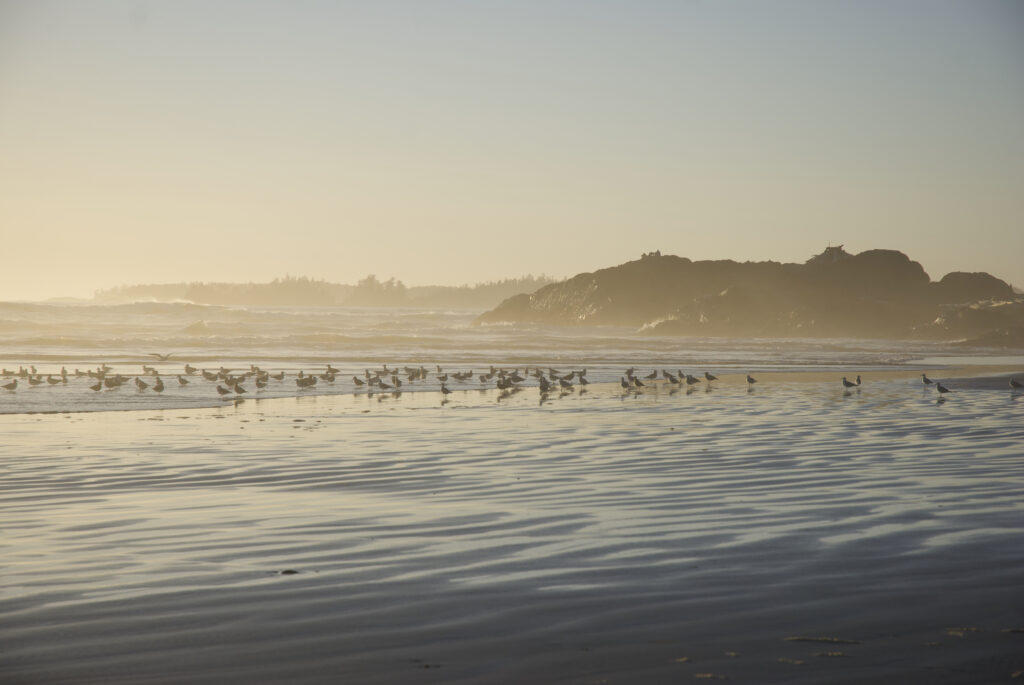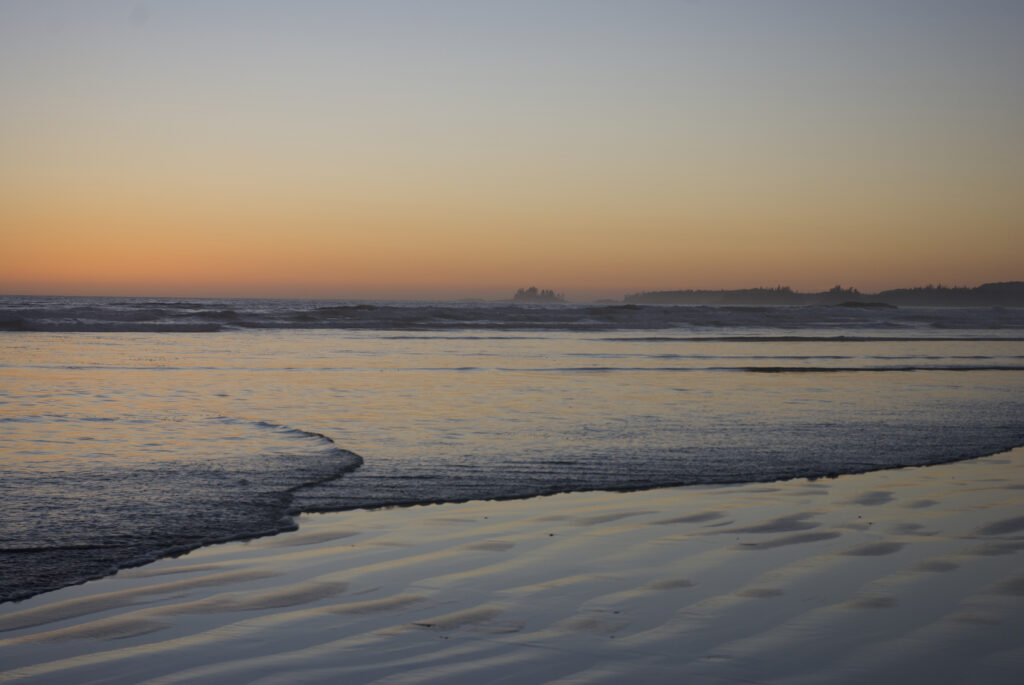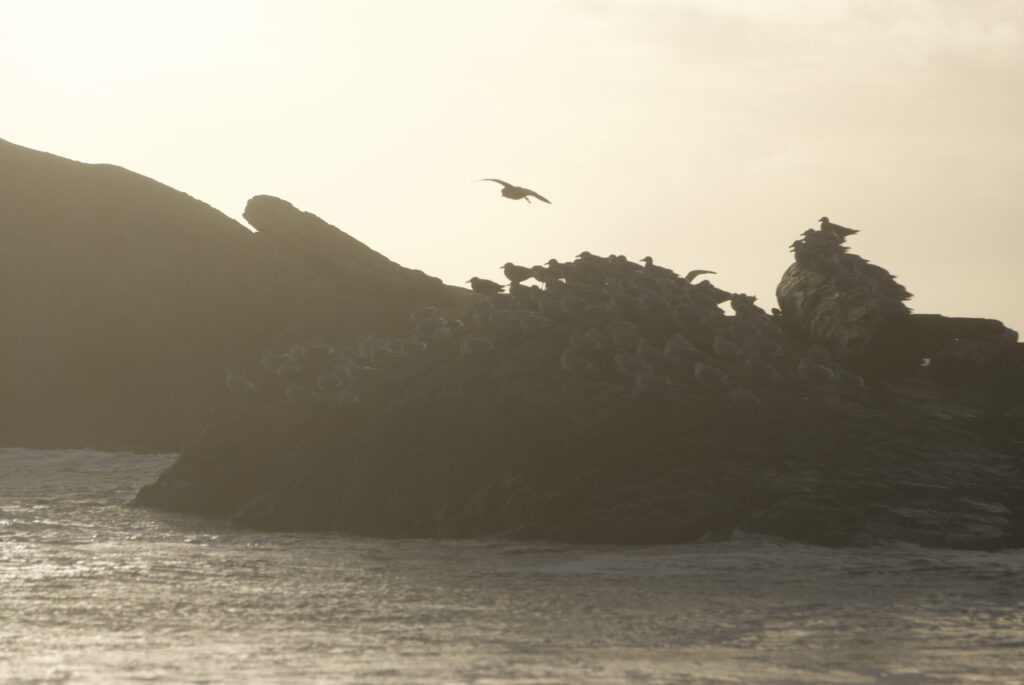May 1, 2024
Shorebird Migration and Magnificent Beaches

by Erin Linn McMullan
At first light on Tin Wis (aka MacKenzie Beach), a small flock of silvery semipalmated sandpipers skims across the sand in a single wave of motion, scattering and regrouping in a beautifully choreographed morning dance. Lifting off with the breeze and then settling again a few feet down shore to fuel up on Nature’s buffet during this critical stopover. Their epic annual journey is a flight to capture the imagination.
Each spring, millions of shorebirds migrate through the west coast of Vancouver Island and Načiks (Tofino) on the Pacific Flyway — considered an “Avian superhighway” with starting points as far south as Patagonia and with destinations in breeding grounds up into the high Arctic.
The instinct to migrate and the ability to navigate incredible distances is hard-wired into these birds, as Mark Maftei, Executive Director of Raincoast Education Society (RES) and a passionate birder, points out. Some species, like the bar-tailed Godwit, hatched in the Arctic, navigate a 7,200-mile nonstop journey across the Pacific Ocean from Alaska to beaches in Aotearoa (New Zealand) and eastern Australia — the longest non-stop flight in the world. While scientists have begun to decipher the “hows” of migrational patterns via tracking using identification bands and geolocators, the “whys” remain elusive.
The complex mystery of birds’ migrational ability relies on a combination of inner compass and visual cues from their in-built magnetoreception and capacity to see the earth’s magnetic field and polarized light, to being guided by celestial cues from the sun and stars above, and recognizing landmarks below from a high altitude as they fly over.
The west coast of Vancouver Island is a welcoming stopover with its diversity of habitats from old-growth temperate rainforest to sandy beaches to mudflats for sandpipers, whimbrels, plovers, and dunlin, to offshore where three species of Albatross, including the black-footed Albatross can be found — all critical habitat in the Western Hemisphere Shorebird Reserve Network (WHSRN) at a time when estuaries are disappearing or under pressure from development.
Maftei, a biologist with extensive field experience, is a driving force in Raincoast Education Society’s programming for the 25th annual Tofino Shorebird Festival which runs until May 5, 2024, and overlaps with peak migration. Maftei will be joined by Liam Ragan from BC Nature as bird guides for free drop-in observations for all ages at the mudflats and co-instructs the intensive Birds of the West Coast weekend workshop (May 3-5) requiring registration.
This weekend course includes lectures and field trips in both Clayoquot and Barkley Sounds with a boat trip on Sunday. One of their youngest registrants for this course in the past was 10 years old, because, as Maftei points out, that passion for birds can be sparked at any age.
All you need to get started is a set of binoculars and a way to identify species whether via field guides like National Geographic Field Guide to the Birds of Western North America or Sibley Birds West, Smart Bird ID or Merlin.
For inspiration and deeper insight, Maftei recommends A World on the Wing: The Global Odyssey of Migratory Birds by Scott Weidensaul.
The opportunity to witness the miracle of migration as well as abundant resident birds is as close as your front doorstep when you stay at Tin Wis Resort, within the Tla-o-qui-aht Tribal Parks and recognized as an Authentic Indigenous BC and Original Original destination. As you stroll down the beach, you can hear seagulls crying out from the roosting rock just offshore, and witness the fishing expeditions of the Pacific Great Blue Heron stalking from “Mushroom” Island’s rocky point and the efficient Osprey swooping out across the surf with gracefully fluttering wings. From above, c̓ixʷatin (Bald Eagle) observes everything from its perch on a branch extending out over the intertidal zone.



“Viewing the shorebirds from the quiet glide of a paddleboard or kayak is magical,” says Catherine Bruhwiler of onsite Tofino Paddle Surf. “We love shorebird season, enjoying the oncoming warmer winds and longer days at the beach. We always advise all paddlers to stay well clear of the seagull nesting grounds just off of Tin Wis. All our rentals include a full safety briefing and recommended paddling safety boundaries.”
A quick walk across the highway takes you to the bottom of Sharp Road and access to viewing platform overlooking peaceful Clayoquot Sound on the Tofino Wah-nah-jus Hilth-hoo-is Mudflats, established as a wildlife management area in 1997, and designated a WHSRN site of regional significance in 2013. Here, especially at high tide, you may spot migrating shorebirds up close as well as birds who overwinter here. This designated area encompasses a total of six tidal sand and mudflat areas, including T̓iičakḥsaʔa (pronounced Tiich-akh-sa-a, aka Grice Bay Point), as well as Chesterman Beach and Yaaqsis (Long Beach) to the west of Esowista.
A favourite birders’ paradise is also within a half-hour’s scenic drive or 25-km bike ride from the resort across the multiuse ʔapsčiik t̓ašii (pronounced ups-cheek ta-shee) trail just past Yaaqsis. Combers Beach, within the co-managed Pacific Rim National Park Reserve, offers a wide expanse of sand bordering the dunes and waves of shorebirds congregating near Sandhill Creek and the Stellar Sea Lion-inhabited rocks on the periphery of Muuyapił (pronounced Muu-ya-pilth, aka Green Point).



Here, prime viewing is possible while giving these fatigued super-athletes plenty of space and from April 1 to October 1, dogs are prohibited to avoid disturbing their rest and refueling. Migratory birds on Combers and the surrounding beaches are protected under Parks Canada amongst a cluster of federal regulations.
Tofino is a bucket-list dream for serious international birders like Geoffrey McMullan, a Nature-based Counsellor/Nature-awareness and Bird Language mentor/instructor based in the UK. He points out the west coast has “waders” (shorebirds) not seen in the east, unless they are blown off course. McMullan, the author and illustrator of More Birds than Bullets, wants to add Western Sandpipers among other birds to his long list of sightings from extreme birding expeditions around the world.
Between 5-20% of the total Western Sandpiper population in North America—one of the most abundant species at approx. 3.5-4 million birds—is estimated to stop here in Načiks (Tofino) during spring migration. Weighing in at just over 20 grams on arrival, these tiny birds add up to 10 grams of fat before departing on a two-day journey to the Copper River Delta in Southeast Alaska 1,118 miles north. Over 20 species of shorebirds pass through this migratory way station. As part of their overall surveying, RES, a Tla-o-qui-aht Tribal Parks Ally, has been Tracking Shorebirds to identify and count flock sizes during spring migration over the past several years.
With the data collected, RES hopes to upgrade the WHSRN status of this critical habitat from a site of regional significance to one of international significance.
Offshore sightings of pelagic sea birds which spend most of their lives out on the open ocean can be amongst the most magical. Albatrosses are pelagic, capable of covering thousands of miles in a few short days during foraging expeditions. The Laysan Albatross has been sighted locally, along with two species at risk, the
Black-footed Albatross (threatened), the most abundant in Clayoquot Sound, and the rarest of North American species, the Short-tailed Albatross (special concern). Albatross breed outside Canada to the south in Mexico, mid-Pacific in Hawaii, and to the northwest in Japan nearly 4,000 nautical miles away.
If you want to explore deeper into Clayoquot Sound, pelagic seabirds are often sighted during whale watching tours, where they are attracted to the same food source, and on the day-long Tofino Hot Springs Eco-Tour with Ahousaht-owned Ahous Adventures. Recently, their guides have observed Pink-footed and Sooty Shearwaters starting to show up again. Rhinoceros Aucklets and Pigeon Guillemots are in breeding plumage now. The Puffins have yet to arrive, but the long-tailed ducks seem to be gone north now.
Tla-o-qui-aht and Ahousaht are working together with the Province of BC to formally establish 77,000 hectares of Indigenous-led conservancies in Clayoquot Sound to continue their stewardship efforts since time immemorial. The community recently celebrated the 40th anniversary of the declaration of the Wanačas Hiłhuuʔis Tribal Park on Meares Island on April 21st.
When you return to Tin Wis Resort from birdwatching, the hot tub is a great way to take the chill off after an active day out on the beach or on the water. Continue unwinding at the adjacent fitness centre and limber up for tomorrow’s adventures.
Now that you’ve worked up an appetite, come #socialize on the pet-friendly patio at Browns Socialhouse to enjoy comfort food and compare notes on those once-in-a-lifetime sightings. Dig into a hearty bowl to satisfy your hunger — West Coast Salmon Poke Bowl (wild, locally-sourced salmon), Dragon Bowl (teriyaki chicken or tofu — gluten-friendly options available) or Southwest Rice Bowl (blackened chicken). Then treat yourself to a housemade dessert!
Dusk and those picture-perfect-sunsets offer a time of high avian activity as you watch the silhouettes of flocks flying in intermittent waves across the chiaroscuro sky. Pay careful attention to spot the resident Anna and Rufous hummingbirds returning from Central America in constant motion (approx. 70 flaps per second) collecting nectar from the natural garden with indigenous plants sprawling out towards the dunes.



From the rainforest, songbirds like the Swainson’s Thrush trill their evening song as the light dims on the landscape, and if you’re lucky and listen carefully, a Barred Owl may call out its chorus of “Who-cooks-for-you?”
If you want to keep the migratory magic going, cozy up around a bonfire in one of the resort’s firepits overlooking the beach, or rent a propane fire kit overnight from the front desk.
Can you spot that solitary Pacific Great Blue Heron at the shoreline during its nighttime foraging or hear its pterodactyl-like screech as it passes overhead with its massive six-and-a-half-foot wingspan? This darker fannini subspecies of heron is confined to the coast from Prince William Sound in Alaska to Puget Sound in Washington in the US, with approx. 2,000 pairs in British Columbia where it is listed as being of special concern. One hundred of these birds are supported by the Tofino Wah-nah-jus Hilth-hoo-is Mudflats each year, but few remain during breeding season. [1] Did you know that the oldest known fossils of the Great Blue Heron date back 1.8 million years to the Pleistocene Epoch?[2].
When you look up at all those constellations painted across the night sky, imagine what it must be like to fly high on such an incredible journey navigating from points all across the globe.
The night sky is alive with activity even as you drift off in your oceanfront suite, your screen door secured, listening to the symphony of birdsong harmonizing with the surf’s lullaby.
What’s on your bucket list for tomorrow?
Limited tickets are available for naaʔuu, a three-hour interactive cultural event and dining experience running from May 22–June 29, 2024. Buy Tickets Here. To stay at Tin Wis during the festivities, click on “Enhance Your Stay” when you Book Here.
Guests of Tin Wis Resort also enjoy a 10% discount for online bookings at Tofino Paddle Surf onsite year-round. Open daily in May from 10 a.m. to 6 p.m. Book Here.
Ask for your discount code when reserving your stay at Tin Wis Resort to receive $20 off your booking with Ahous Adventures online or by calling 250-725-0650. Ahous Adventures is located downtown at 368 Main Street, Unit 313.
To make online reservations for lunch or dinner or order food for pickup at Tofino Browns Socialhouse, visit their website here & come enjoy their new dog-friendly patio!
Tofino Wine & Dine 2024 Event Information and Tickets Available Here. Reserve your room now from May 31st to June 3rd (2-night minimum). Book Here or by calling the resort. For longer stays, please email: reservations@tinwis.ca
[1] Status and Conservation Stewardship of the Pacific Great Blue Heron in Canada.
[2] Great Blue Heron, American Bird Conservancy.
